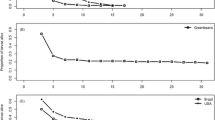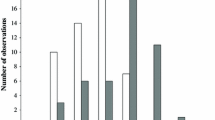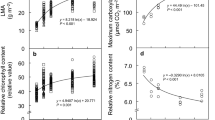Abstract
Both biotic and abiotic selection pressures can contribute to geographic variation in allelochemical production in plants. We examined furanocoumarin production in western North American populations of Heracleum lanatum and Pastinaca sativa that, at different latitudes and altitudes, experience different ultraviolet (UV) light regimes. Total furanocoumarins and linear furanocoumarins of fruits were negatively correlated with UV irradiance, whereas amounts of angular furanocoumarins, which are generally less phototoxic, were not. Another factor potentially influencing furanocoumarin production is the presence of the parsnip webworm Depressaria pastinacella, (Lepidoptera: Oecophoridae), an herbivore that feeds on reproductive structures of both plant species. These insects sequester lutein from their host plants; this carotenoid acts to ameliorate furanocoumarin toxicity. Although the concentration of lutein in fruits did not vary with UV irradiance, lutein sequestration by sixth instars was positively correlated with UV irradiance. Webworm populations are variably infested with the polyembryonic webworm parasitoid Copidosoma sosares Walker (Hymenoptera: Encyrtidae). H. lanatum fruits from populations with webworms parasitized by C. sosares had lower concentrations of furanocoumarins, with the exception of sphondin, than fruits from plants infested with webworms free from parasitism. Lower levels of these furanocoumarins may reduce negative effects on the fitness of this parasitoid. In contrast with the variation in furanocoumarin content, the ability of webworms to metabolize furanocoumarins by cytochrome P450 did not differ significantly among populations from New Mexico to Alberta.








Similar content being viewed by others
References
Adams, D. K. and Comrie, A. C. 1997. The North American monsoon. Bull. Am. Meteorol. Soc. 78:2197–2213.
Ahmad, S. and Pardini, R. S. 1990. Mechanisms for regulating oxygen toxicity in phytophagous insects. Free Radic. Biol. Med. 8:401–413.
Ali, A., Lutterell, R. J., and Schneider, J. C. 1990. Effects of temperature and larval diet on development of the fall armyworm. Ann. Entomol. Soc. Am. 83:725–733.
Arnason, J. T., Philogène, B. J., and Towers, G. H. N. 1992. Phototoxins in plant–insect interactions, pp. 313–343, in G. A. Rosenthal and M. R. Berenbaum (eds.) Herbivores: Their Interactions with Secondary Plant Metabolites, 2nd edn. Vol. II: Evolutionary and Ecological Processes. Academic Press, San Diego, CA.
Aucoin, R. R., Fields, P., Lewis, M. A., Philogène, B. J. R., and Arnason, J. T. 1990. The protective effect of antioxidant to a phototoxin-sensitive insect herbivore, Manduca sexta. J. Chem. Ecol. 16:2913–2924.
Aucoin, R. R., Guillet, G., Murray, C., Philogene, B. J. R., and Arnason, J. T. 1995. How do insect herbivores cope with the extreme oxidative stress of phototoxic host plants? Arch. Insect. Biochem. Physiol. 29:211–226.
Baldwin, I. T. and Preston, C. A. 1999. The eco-physiological complexity of plant responses to insect herbivores. Planta 208:137–145.
Berenbaum, M. R. 1981. Patterns of furanocoumarin distribution and insect herbivory in the Umbelliferae: Plant chemistry and community structure. Ecology 62:1254–1265.
Berenbaum, M. R. 1991. Coumarins, pp. 221–249, in G. A. Rosenthal and M. R. Berenbaum (eds.). Herbivores: Their Interactions with Secondary Plant Metabolites, 2nd edn. Vol. I: The Chemical Participants. Academic Press, New York.
Berenbaum, M. R. and Zangerl, A. R. 1991. Acquisition of a native hostplant by an introduced oligophagous herbivore. Oikos 62:153–159.
Berenbaum, M. R. and Zangerl, A. R. 1992. Genetics of physiological and behavioral resistance to host furanocoumarins in the parsnip webworm. Evolution 46:1373–1384.
Berenbaum, M. R. and Zangerl, A. R. 1998. Chemical phenotype matching between a plant and its insect herbivore. Proc. Natl. Acad. Sci. U. S. A. 95:13743–13748.
Berenbaum, M. R., Zangerl, A. R., and Nitao, J. K. 1986. Constraints on chemical coevolution: Wild parsnips and the parsnip webworm. Evolution 40:1215–1228.
Bianchi, L., Melli, R., Pizzala, R., Stivala, L. A., Rehak, L., Quarta, S., and Vannini, V. 1996. Effects of β-carotene and α-tocopherol on photogenotoxicity induced by 8-methoxypsoralen: The role of oxygen. Mutat. Res. 369:183–194.
Bidigare, R. R., Ondrusek, M. E., Kennicutt, M. C., Turriaga, R., Harvey, H. R., Hoham, R. W., and Macko, S. A. 1993. Evidence for a photoprotective function for secondary carotenoids of snow algae. J. Phycol. 29:427–434.
Blumthaler, M., Ambach, W., and Elliner, R. 1997. Increase in solar UV radiation with altitude. J. Photochem. Photobiol., B Biol. 39:130–134.
Borgeraas, J. and Hessen, D. O. 2002. Variations of antioxidant enzymes in Daphnia species and populations as related to ambient UV exposure. Hydrobiologia 477:15–30.
Britton, G. 1993. Carotenoids in chloroplast pigment–protein complexes, pp. 448–485, in C. Sundqvist and M. Ryberg (eds.). Pigment–Protein Complexes in Plastids: Synthesis and Assembly. Academic Press, San Diego, CA.
Burton, G. and Ingold, K. 1984. β-Carotene: An unusual type of lipid antioxidant. Science 224:569–573.
Carroll, M., Hanlon, A., Hanlon, T., Zangerl, A. R., and Berenbaum, M. R. 1997. Behavioral effects of carotenoid sequestration by the parsnip webworm, Depressaria pastinacella. J. Chem. Ecol. 23:2707–2719.
Coleman, R. A., Barker, A. M., and Fenner, M. 1999. Parasitism of the herbivore Pieris brassicae L. (Lep., Pieridae) by Cotestia glomerata L. (Hym., Braconidae) does not benefit the host plant by reduction of herbivory. J. Appl. Entomol. 123:171–177.
Demmig-Adams, B. and Adams, W. W. 1996. The role of xanthophyll cycle carotenoids in the protection of photosynthesis. Trends Plant Sci. 1:21–26.
Diffey, B. L. 1991. Solar ultraviolet radiation effects on biological systems. Phys. Med. Biol. 36:299–328.
Eichler, O., Sies, H., and Stahl, W. 2002. Divergent optimum levels of lycopene, beta-carotene, and lutein protecting against UVB irradiation in human fibroblasts. Photochem. Photobiol. 75:503–506.
Feltwell, G. W. 1978. The distribution of carotenoids in insects. pp. 2203–2215, in J. B. Harborne (ed.). Biochemical Aspects of Plant and Animal Coevolution. Academic Press, London.
Fields, P., Arnason, J. T., and Philogene, B. J. 1990. Behavioral and physical adaptations of three insects that feed on the phototoxic plant Hypericum perforatum. Can. J. Zool. 68:339–346.
Frankel, S. and Berenbaum, M. 1999. Effects of light regime on antioxidant content of foliage in a tropical forest community. Biotropica 31:422–429.
Gogan, P. J. and Barrett, R. H. 1995. Elk and deer diets in a coastal prairie-scrub mosaic, California. J. Range Manag. 48:327–335.
Goulson, D. 1994. Determination of larval melanization in the moth, Mamestra brassicae, and the role of melanin in thermoregulation. Heredity 73:471–479.
Green, E. S. and Berenbaum, M. R. 1994. Phototoxicity of citral to Trichoplusia ni (Lepidoptera: Noctuidae) and its amelioration by vitamin A. Photochem. Photobiol. 60:459–462.
Hamer, D., Herrero, S., and Brady, K. 1991. Food and habitat used by grizzly bears, Ursus arctos, along the Continental Divide in Waterton Lakes National Park, Alberta. Can. Field-Nat. 105:325–329.
Hansen, U., Fiedler, B., and Rank, B. 2002. Variation of pigment composition and antioxidative systems along the canopy light gradient in a mixed beech/oak forest: A comparative study on deciduous tree species differing in shade tolerance. Trees 16:254–264.
Harvey, J. A., Jervis, M. A., Gols, R., Jiang, N., and Vet, L. E. M. 1999. Development of the parasitoid, Cotesia rubecula (Hymenoptera: Braconidae) in Pieris rapae and Pieris brassicae (Lepidoptera: Pieridae): Evidence for host regulation. J. Insect Physiol. 45:173–182.
Hodges, R. W. 1974. Gelechiodea: Oecophoridae (In Part). Moths of America North of Mexico Fasc. 6.2. E. W. Classey Ltd. and R. B. D. Publications, London.
Holcroft, A. C. and Herrero, S. 1991. Black bear, Ursus americanus, food habits in southwestern Alberta. Can. Field-Nat. 105:335–345.
Jahnke, L. S. 1999. Massive carotenoid accumulation in Dunaliella bardawil induced by ultraviolet-A radiation. J. Photochem. Photobiol., B Biol. 48:69–74.
Johnson, K. S. and Barbehenn, R. V. 2000. Oxygen levels in the gut lumen of herbivorous insects. J. Insect Physiol. 46:897–903.
Jung, S., Steffen, K. L., and Lee, H. J. 1998. Comparative photoinhibition of a high and low altitude ecotype of tomato (Lycopersicon hirsutum) to chilling stress under high and low light conditions. Plant Sci. 134:69–77.
Karban, R. and Englishloeb, G. 1997. Tachinid parasitoids affect host plant choice by caterpillars to increase caterpillar survival. Ecology 78:603–611.
Kayser, H. 1985. Pigments, pp. 368–416, in G. A. Gilbert (ed.). Comprehensive Insect Physiology, Biochemistry and Pharmacology, Vol. 10. Pergamon Press, Oxford.
Koptur, S. 1985. Alternative defenses against herbivores in Inga (Fabaceae: Mimosoideae) over an elevation gradient. Ecology 66:1639–1650
Krinsky, N. I. 1989. Antioxidant functions of carotenoids. Free Radic. Biol. Med. 7:617–635.
Larson, R. A. 1988. The antioxidants of higher plants. Phytochemistry 27:969–978.
Larson, R. A., Garrison, W. J., and Carlson, R. W. 1991. Differential responses of alpine and non-alpine Aquilegia spp. to increased UV-B radiation. Plant Cell Environ. 13:938–988.
McKenna, D. and Berenbaum, M. R. 2003. A field investigation of Depressaria (Elachistidae) host plants and ecology in the western United States. J. Lepid. Soc. 37:36–42.
McMillan, J. F. 1953. Some feeding habits of moose in Yellowstone Park. Ecology 34:102–110.
National Oceanic and Atmospheric Administration. 2003. Solar Position Calculator (http://www.srrb.noaa.gov/highlights/sunrise/azel.html).
Nitao, J. K. 1989. Enzymatic adaptation in a specialist herbivore for feeding on furanocoumarin-containing plants. Ecology 70:629–635.
Nitao, J. K. and Berenbaum, M. R. 1988. Laboratory rearing of the parsnip webworm, Depressaria pastinacella (Lepidoptera: Oecophoridae). Ann. Entomol. Soc. Am. 81:485–487.
O'Neil, C. and Schwartz, S. J. 1992. Chromatographic analysis of cis/trans carotenoid isomers. J. Chromatogr. 624:235.
Ode, P. J., Berenbaum, M. R., Zangerl, A. R., and Hardy, I. C. W. 2004. Host plant, host plant chemistry and the polyembryonic parasitoid Copidosoma sosares: Indirect effects in a tritrophic interaction. Oikos104:388–400.
Ode, P. J. 2006. Plant chemistry and natural enemy fitness: effects on herbivore and natural enemy interactions. Annu. Rev. Entomol. (doi: 10.1146/annurev.ento.51.110104.151110). First posted online on July 25, 2005.
Oliver, J. and Palou, A. 2000. Chromatographic determination of carotenoids in foods. J. Chromatogr. A 881:543–555.
Palozza, P., Luberto, C., Calviello, G., Ricci, P., and Bartoli, G. M. 1997. Antioxidant and prooxidant role of β-carotene in murine normal and tumor thymocytes: Effects of oxygen partial pressure. Free Radic. Biol. Med. 22:1065–1073.
Polle, A., Baumbusch, L. O., Oschinski, C., Eiblmeier, M., Kuhlenkamp, V., Vollrath, B., Scholz, F., and Rennenberg, H. 1999. Growth and protection against oxidative stress in young clones and mature spruce trees (Picea abies L.) at high altitudes. Oecologia 121:149–156.
Preszler, R. W. and Boecklen, W. J. 1996. The influence of elevation on tritrophic interactions: Opposing gradients of top-down and bottom-up effects on a leaf-mining moth. Ecoscience 3:75–80.
Price, P. W., Bouton, C. E., Gross, P., Mcpheron, B. A., Thompson, J. N., and Weis, A. E. 1980. Interactions among three trophic levels: Influence of plants and interactions between insect herbivores and natural enemies. Ann. Rev. Ecolog. Syst. 11:41–65.
Rahbé, Y., Digilio, M. C., Febvay, G., Guillaud, J., Fanti, P., and Pennacchio, F. 2002. Metabolic and symbiotic interactions in amino acid pools of the pea aphid, Acyrthosiphon pisum, parasitized by the braconid Aphidius ervi. J. Insect Physiol. 48:507–516.
Rahman, M. 1970. Effects of parasitism on food consumption of Pieris rapae larvae. J. Econ. Entomol. 63:820–821.
Ralph, M. H. and Pfister, J. A. 1992. Cattle diets in tall forb communities on mountain ranges. J. Range Manag. 45:534–537.
Ramcharita, R. K. 2000. Grizzly bear use of avalanche chutes in the Columbia Mountains, British Columbia. Ph.D. dissertation, The University of British Columbia, Vancouver.
Rawlins, J. E. and Lederhouse, R. C. 1981. Developmental influences of thermal behavior on monarch caterpillars (Danaus plexippus): An adaptation for migration (Lepidoptera: Nymphalidae: Danainae). J. Kans. Entomol. Soc. 54:387–408.
Reitz, S. R. and Trumble, J. T. 1996. Tritrophic interactions among linear furanocoumarins, the herbivore Trichoplusia ni (Lepidoptera: Noctuidae), and the polyembryonic parasitoid Copidosoma floridanum (Hymenoptera: Encyrtidae). Environ. Entomol. 25:1391–1397.
Riley, C. V. 1889. The parsnip webworm (Depressaria heracliana DeG.). Insect Life 1:94–98.
Riso, P. and Porrini, M. 1997. Determination of carotenoids in vegetable foods and plasma. Int. J. Vitam. Nutr. Res. 67:47–54.
Robertson, J. and Beatson, E. 1985. Enhancement of dye-sensitized phototoxicity to housefly larvae in vivo by dietary ascorbate, diazabicyclooctane, and other additives. Pestic. Biochem. Physiol. 24:375–383.
Rothschild, M., Mummery, R. and Farrell, C. 1986. Carotenoids of butterfly models and their mimics (Lep: Papilionidae and Nymphalidae). Biol. J. Linn. Soc. 28:359–372.
Salmore, A. K. and Hunter, M. D. 2001. Elevational trends in defensive chemistry, vegetation, and reproduction in Sanguinaria canadensis. J. Chem. Ecol. 27:1713–1727.
Schmucki, D. A. and Philipona, R. 2002. Ultraviolet radiation in the Alps: The altitude effect. Opt. Eng. 41:3090–3095.
Slansky, F. 1978. Utilization of energy and nitrogen by larvae of the imported cabbageworm, Pieris rapae, as affected by parasitism by Apanteles glomeratus. Environ. Entomol. 7:179–185.
SPSS. 1999. SPSS 9.0. SPSS, Inc. Chicago.
Tenney, S. M. 1985. Oxygen supply and limiting oxygen pressure in an insect larva. Respir. Physiol. 60:121–134.
Thompson, J. N. 1999. Specific hypotheses on the geographic mosaic of coevolution. Am. Nat. 153(Supplemental S):S1–S14.
Timmins, G., Penatti, C. A., Bechara, E., and Swartz, H. M. 1999. Measurement of oxygen partial pressure, its control during hypoxia and hyperoxia, and its effect upon light emission in a bioluminescent elaterid larva. J. Exp. Biol. 202:2631–2638.
Turlings, T. C. J. and Benrey, B. 1998. Effects of plant metabolites on the behavior and development of parasitic wasps. Ecoscience 5:321–333.
University of Georgia and Environmental Protection Agency. 2003. National Ultraviolet Monitoring Center. http://oz.physast.uga.edu/choose_site_data.html.
Valadon, L. and Mummery, R. S. 1978. A comparative study of carotenoids in Papilio spp. Comp. Biochem. Physiol., B 61B:371–374.
Vega, M. P. and Pizarro, R. A. 2000. Oxidative stress and defense mechanisms of the freshwater cladoceran Daphnia longispina exposed to UV radiation. J. Photochem. Photobiol., B Biol. 54:121–125.
Willemsen, R. E. and Hailey, A. 1999. A latitudinal cline of dark plastral pigmentation in the tortoise Testudo hermanni in Greece. Herpetol. J. 9:125–132.
Yeum, K. J., Booth, S. L., Sadowski, J. A., Liu, C., Tang, G., Krinsky, N. I., and Russell, R. M. 1996. Human plasma response to the ingestion of controlled diets high in fruits and vegetables. Am. J. Clin. Nutr. 64:594–602.
Young, D. R. 1985. Microclimate effects on water relations, leaf temperatures, and the distribution of Heracleum lanatum at high elevations. Am. J. Bot. 72:357–364.
Zangerl, A. R. and Berenbaum, M. R. 1997. Cost of chemically defending seeds: Furanocoumarins and Pastinaca sativa. Am. Nat. 150:491–504.
Zangerl, A. R. and Berenbaum, M. R. 2003. Phenotype matching in wild parsnip and parsnip webworms: Causes and consequences. Evolution 57:806–815.
Zangerl, A. R., Berenbaum, M. R., Delucia, E. H., and Nitao, J. K. 2003. Fathers, fruits and photosynthesis: Pollen donor effects on fruit photosynthesis in wild parsnip. Ecol. Lett. 6:966–970.
Acknowledgments
We thank Lynn Anderson for assistance with collections, Paul Ode for advice on C. sosares, John Noyes for wasp identification, John Erdman and Denise Deming for advice on carotenoids, and Kemin, Inc. for the lutein standard. This work was supported by National Science Foundation DEB 99-03867 and DEB 02-35773.
Author information
Authors and Affiliations
Corresponding author
Rights and permissions
About this article
Cite this article
Carroll, M.J., Berenbaum, M.R. Lutein Sequestration and Furanocoumarin Metabolism in Parsnip Webworms Under Different Ultraviolet Light Regimes in the Montane West. J Chem Ecol 32, 277–305 (2006). https://doi.org/10.1007/s10886-005-9002-y
Received:
Revised:
Accepted:
Published:
Issue Date:
DOI: https://doi.org/10.1007/s10886-005-9002-y




